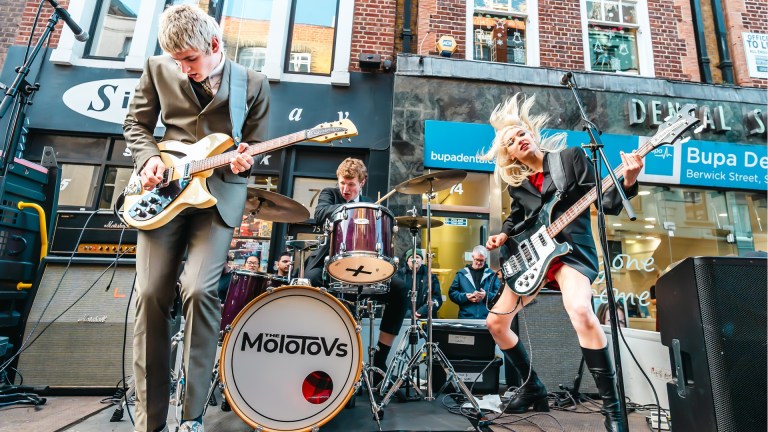“August of 2021, New Orleans Jazz Festival had already moved to the spring from fall. And with that move, everyone was very excited because it was this opportunity to make money and open the doors for real (post lockdown), not just a sit-down show for 40 people, with no margin,” Greenebaum tells me. “Then they cancelled it entirely. And there was an article in the paper about how this cancellation was such a letdown and the impact for the venues and musicians because they had been so geared up for the lights to finally come back on.”
Crestfallen on behalf of the city’s musicians, venues and hotels, Greenebaum resolved to find a way to build on the positive momentum they had just started to regain. “And in the meantime,” he says, “all the other festivals for the fall cancelled: Voodoo, BUKU, Fried Chicken Festival, French Quarter Festival.
“And so I started calling these guys and saying I’ve got an idea – what if we could market all the venues as one thing and say to the world, don’t cancel your ticket, don’t cancel your hotel room? Don’t cancel your dinner reservation. Come.”
Out of those embers NOLAxNOLA was forged – a sprawling 10-day, 55-venue, multi-genre musical celebration touching every corner of the city, from neighbourhood dives to chic cocktail bars, renowned music halls to Bourbon Street tourist traps (“The unofficial slogan,” Sig tells me, “is every genre, every neighbourhood, every night.”)
I spend my first night at the festival on Oak Street at the Maple Leaf Bar, a charming hangout in a bohemian part of town with buzzing neon signs and a tin ceiling. A small crowd has gathered to watch a Rage Against The Machine tribute band fronted by a woman called Sage, who bounces around the stage frenetically to pitch-perfect covers. This is undoubtedly not what I was expecting from a New Orleans music festival, and the audience’s enthusiasm tells me this group is a local favourite.
The next evening, I head to Broadside, near the Treme, for a NOLAxNOLA-affiliated event called Black Americana Fest. Food trucks serve up gumbo, fried chicken and shaved ice while Layla McCalla plays beautiful music on an outdoor stage, alternating between her cello and her Gibson Les Paul. Among the audience are old friends and acquaintances reuniting delightedly and young children tearing around picnic tables in the balmy evening heat. I am once again likely the only tourist in attendance. It’s like being invited behind a well-worn velvet rope.
Strolling up Magazine Street later in the week, I stop by Nola ’Nacular, a gallery selling screen prints and photographs by local artists. Its proprietor Anthony DelRosario chats to me about NOLAxNOLA. It turns out we’re attending the same event that afternoon, a gig in a French Quarter dive bar called Santos, marking the return of local rock legends Supagroup. “Better bring earplugs,” he warns.
I’m grateful for this advice. The venue is dark and crowded despite the 4pm start time, and the band rumble deafeningly through a back catalogue of tight, heavy fan favourites. “That was a really big deal,” Greenebaum tells me afterwards. “Because they haven’t played together in 10, 11 years.” He is keen to highlight exclusives and one-offs in the festival’s repertoire. NOLAxNoCover saw venues on Frenchman Street waiving ticket fees for all live music during opening weekend.
At Tipitinas, a local institution on the banks of the Mississippi, NOLA royalty like Irma Thomas, Cyrille Neville, Kermit Ruffins and Stanton Moore play a raucous tribute to Stevie Wonder. “When you come for this festival, you’re seeing not just New Orleans, but New Orleans on steroids,” he says.
Stanton Moore is something of an institution himself, and it’s a thrill to catch him playing drums at a hotel bar with longtime collaborator, the bassist and composer James Singleton. After floating through a couple of standards, Singleton plugs his upright bass into a guitar pedal. The resulting sound, mellifluent and hallucinatory, has the small room captivated. “I grew up listening to Hendrix,” he shrugs when I quiz him about it afterwards.
NOLAxNOLA allows visitors like me to experience New Orleans nightlife as locals do, like an insider’s crib sheet. This is the Big Easy I came here for. From its beginnings as a means to support the city’s ailing local venues, Greenebaum is confident of the festival’s future. “We’re starting to find our way,” he says. “I have a philosophy on life that I call ‘the crescendo effect’. Crescendo to bigger and better. Like music, you have a crescendo. It starts small and it ends up loud. Right?”
Do you have a story to tell or opinions to share about this? Get in touch and tell us more. Big Issue exists to give homeless and marginalised people the opportunity to earn an income. To support our work buy a copy of the magazine or get the app from the App Store or Google Play.









